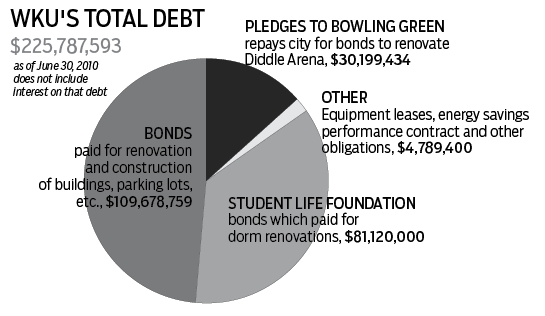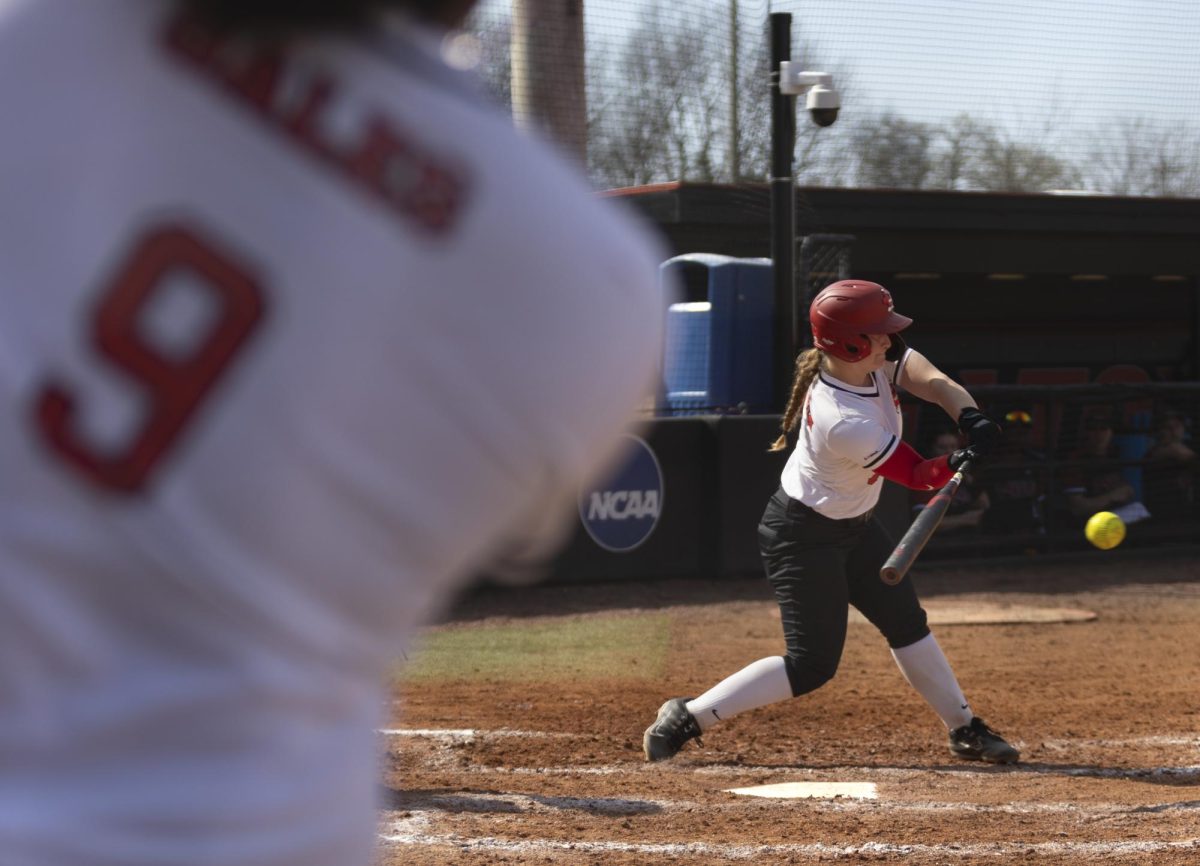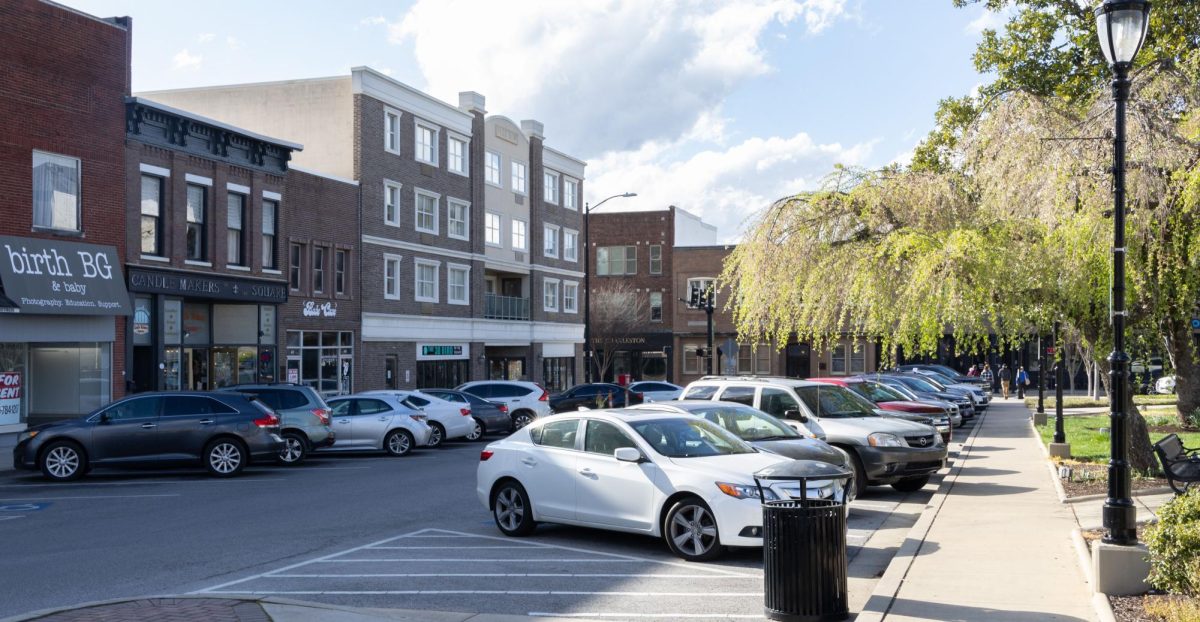WKU finds creative solutions to alleviate debt concerns
May 6, 2011
Graduating seniors will soon leave a campus quite different than the one they first walked onto as freshmen four or five years ago.
In those five years, WKU has finished about a dozen construction projects, from renovating the historic Van Meter Hall to building the 120,000-square-foot Ransdell Hall.
But an aggressive building campaign comes at a price.
Jim Cummings, WKU’s chief financial officer, said the university is like most businesses and families in that it has to borrow money for many of its big projects — those the state doesn’t provide money for.
As of June 30, 2010, WKU had a debt of $144.7 million, most of which is owed for bonds sold to pay for construction projects. Bonds allow investors to lend money to an entity, such as WKU, which then repays the debt with interest. WKU will make payments twice a year until it’s paid off.
WKU’s bonds and other debt will be repaid over the next 20 years or so, along with $62.3 million in interest, according to the university’s 2010 audit report.
Those numbers don’t include $81.1 million that the Student Life Foundation owes for bonds which paid for dorm renovations.
The university will sell another $33.5 million in bonds, probably in early 2012, to renovate Downing University Center, Cummings said.
Just last week the Board of Regents approved a $70 per semester student fee to pay back those bonds over the next 20 years.
Cummings isn’t concerned about WKU’s growing debt.
“I wouldn’t be comfortable sitting in this chair and doing the job I’m doing if I felt like we were incurring more debt than we could pay,” he said.
Cummings noted that Standard & Poor’s, an independent company that rates institutions’ credit scores, upgraded WKU’s rating from “stable” to “positive” in February. Their report cited, among other reasons, continued enrollment growth and a manageable debt burden for the upgrade.
That’s enough for President Gary Ransdell.
“These are the people that would tell us if our debt is out of balance,” he said.
Ransdell said he isn’t concerned about WKU’s debt, because it isn’t a significant amount of the university’s annual budget.
WKU will pay $12.7 million toward debt during the 2010-2011 school year, according to university budget documents. That’s about 4.7 percent of the $270.9 million unrestricted budget, which comes mostly from tuition and state appropriations.
“Julie and I built a house recently,” Ransdell said. “I wish our mortgage payment was only 4.7 percent of my income.”
Associate history professor Eric Reed said it’s not the amount WKU spends on paying debt that worries him, but the fact that the money could go to academics instead.
“We have limited resources, and when we spend a dollar on something, we can’t spend it on something else,” he said. “If we spend a dollar on buildings, we can’t spend it on academics. If we spend a dollar on athletics, we can’t spend it on new faculty.”
With less state money going to universities, tuition and other money becomes more important, Reed said.
Ransdell said that going forward the priority will have to be on hiring new faculty and increasing academic quality.
“Most of what we’ve done in the past have been exceptional things,” he said. “We’re just not going to have the window of opportunity to fund those exceptional things much more in the future.”
A campus needing a transformation
When Ransdell, a 1973 WKU graduate, became president in 1997, he wasn’t happy with the campus he returned to. He said the buildings were old and deteriorating, and the last academic building was built in 1976.
“So we were in desperate need of not only additional academic space, but the space that we had was in pretty bad shape,” Ransdell said.
He said the campus was on the verge of losing the beauty and distinctiveness that attracted students to WKU.
“I had no idea how we were going to go about it, but that clearly had to be something that my time as president had to focus on,” Ransdell said. “It was rebuilding the campus and restoring the grounds to their natural beauty.”
Construction projects on campus can generally be paid for in three ways. The state can provide the money, as it did to build Mass Media and Technology Hall and Ransdell Hall, the new home of the College of Education. Or the university can find the money itself, either through collecting private donations or selling bonds.
Donations funded the new Chandler Chapel and will soon pay for the new Augenstein Alumni Center, while bonds have paid for the renovations to Preston Center and construction of the music hall.
It’s up to the governor and the Kentucky General Assembly to decide whether the state will pay for a project or if the university must sell bonds, said Sherron Jackson, associate vice president for budget, planning and policy for the Council on Postsecondary Education, the government body that oversees Kentucky universities. The legislature still has to give permission for a university to sell bonds.
The state only pays for educational and general-use buildings, he said. For other projects, such as athletic facilities or dorms, the university has to come up with its own funding.
Jackson said all the state universities want to improve their campus facilities, and if they don’t, “they believe they’re not competing well for the best and brightest students.”
Thinking creatively
In addition to aggressively pursuing state money and looking for private donations, Ransdell said WKU began thinking creatively to find money for projects.
“There were things that we were doing that had not been done in Kentucky before or almost any other public institution,” he said. “But we were willing to take some risks and have a good business model.”
In 2002, the city of Bowling Green sold bonds on behalf of WKU to pay for renovations to Diddle Arena.
The university uses part of a $205 student athletics fee to pay the city, which then pays the debt each year. The outstanding debt there includes about $30 million, according to the university audit report.
The agreement allowed the renovation of Diddle without the university actually selling bonds, Ransdell said.
Also, in 1999 at the suggestion of Ransdell, the Board of Regents voted to sell 17 of its 18 dorms to the newly formed Student Life Foundation.
That allows the foundation to sell bonds for dorm construction projects without getting state permission, said Brian Kuster, director of Housing and Residence Life.
The money HRL collects from room and board fees goes to the Student Life Foundation, which uses part of it to pay the debt.
The idea, one unique to Kentucky colleges, came about after a dorm fire at Murray State University killed a student in 1997, Kuster said. The state then required all universities to add sprinkler systems in dorms.
Ransdell said he and a local attorney developed a plan for the foundation on a napkin over dinner at a local restaurant. It was a way to add sprinkler systems and renovate all the dorms.
“We’ve marched forward ever since, and now we’ve renovated every single building on campus,” he said. “And the beauty of it is, we’ve kept our residence hall rates right within market of all the other universities in the state.”
Almost $110 million has been invested in the dorms over the past decade, while most other universities have renovated a handful of their dorms, Kuster said.
The foundation owes about $81.1 million in debt to be paid back in installments until 2030. It’ll be paying cash for new student apartments it’s constructing around the new parking garage between Kentucky and Center streets adjacent to campus, he said.
The agreement on its existing bonds requires the foundation to have an income that’s 20 percent greater than the interest on its debt, Kuster said. The result is a surplus of money each year.
That money is spent on maintaining current buildings or investing in smaller projects such as the new apartments.
Moving forward
The Board of Regents approved WKU’s new 2012-2018 capital plan last week. The list prioritizes the university’s construction goals over the next six years, which totals about $750 million.
Renovation of the Thompson Complex North Wing and construction of a new College of Business building are high on the list, but Ransdell said those would have to be paid for by the state.
“I don’t anticipate other student fees before this one is paid off,” he said, referring to the new fee to pay for DUC renovations. “We’ll do projects, but I don’t see projects coming out of tuition going forward.”
And Ransdell said with less money from the legislature going toward capital projects, it’ll be tough.
“I find myself right now in 2011 much like I did in 1997,” he said. “I know we’ve got a lot more we’ve got to do. I’m just not sure how we’re going to get it done.”
But Ransdell said if the president isn’t willing to take on those challenges, they won’t get done.
“To me, I find that an exciting part of the job,” he said. “We took the challenge, and we’re finding ways to do it.”




















![Students cheer for Senator at Large Jaden Marshall after being announced as the Intercultural Student Engagement Center Senator for the 24th Senate on Wednesday, April 17 in the Senate Chamber in DSU. Ive done everything in my power, Ive said it 100 times, to be for the students, Marshall said. So, not only to win, but to hear that reaction for me by the other students is just something that shows people actually care about me [and] really support me.](https://wkuherald.com/wp-content/uploads/2024/04/jadenmarshall-600x422.jpg)




